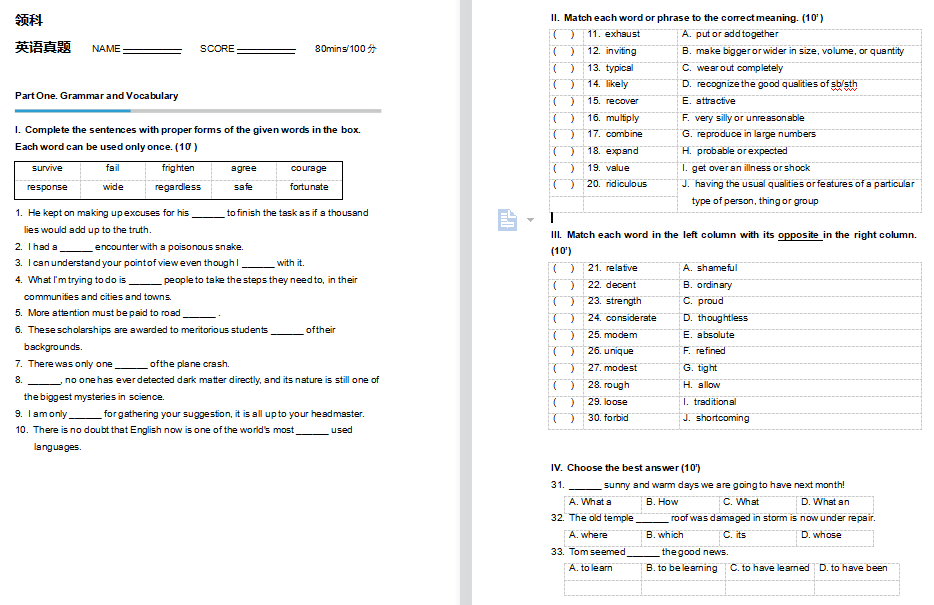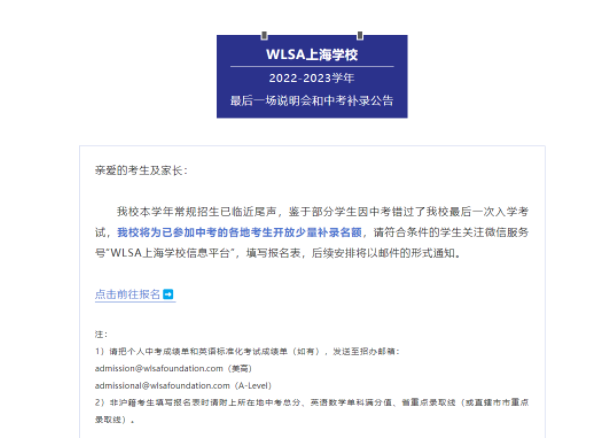 全国
全国

一文全解!上海国际学校入学测试考什么?
来源:国际教育前线发布时间:2023-07-06 17:28:10
现在越来越多的家长倾向于双轨制,双轨指的是指的是体制内外兼顾,未来的升学方向既可以是国内高校,又可以是海外名校。那么,上海国际学校入学测试考什么?很多同学不知道入学测试考什么,需要做哪些准备?接下来,小编给大家汇总了上海领科、光华剑桥、WLSA上海入学考试范围/考情分析/真题测试卷。(点击查看:盘点!7月上海国际学校开放日活动一览表(附课程体系、考试科目))
上海国际学校
作为沪上有名的“牛剑收割机”,领科的入学考试难度相当高,特别是对英语能力的要求。领科考纲中词汇量要求达到了3000词,但这只是一个基础的要求,达不到基本上可以不用考虑领科了。要知道雅思6.5的词汇量要求是6000-7000词,而要想在考试中脱颖而出,考生的词汇量最好要达到4000-4500。据考生反馈,领科英语考试原题会出自高考模拟卷、大学四级模拟卷以及雅思真题。(在线预约看校)
领科比较特别的一点是它的入学考试还会考察科学,也就是物理、化学;数学的话,领科的数学考试中竞赛内容的占比正在逐步增加。
考试范围
领科官网直接大大方方地放了考试范围,可以查看:
| 在读初三考试范围(报考四年制课程),数学、科学为中文卷 | |
| 英语 | · 词汇量 3000 · 题型包括: 词汇:选择题,同义/反义词,选词填空, 语法:完形填空 阅读理解 写作 (150-200字) |
| 数学 |
|
| 物理 |
|
| 化学 |
化学实验:(1)基本操作和常见仪器试剂;(2)气体的实验室制法;(3)有关物质分离方法和盐的制备 的实验★
|
| 在读高一考试范围(报考三年制课程),数学、科学为中文卷 | |
| 英语 | · 词汇量 3500 · 题型包括:词汇,语法,阅读理解和写作 (150-200字) |
| 数学 |
|
| 物理 |
|
| 化学 |
基本化学用语。酸碱盐性质和其质量,浓度等的相关计算 ★
|
| 在读高二考试范围(报考二年制课程),数学中文卷 | |
|
英语 |
· 词汇量 4000 · 题型包括:词汇,语法(复合句,非谓语动词,倒装,虚拟) 阅读理解和写作 (300字) |
| 数学 |
· 函数(幂、对、指数函数、反函数★) · 平面向量 |
| 在读国际课程初三考试范围(报考四年制课程)数学、科学为英文卷 | |
| 数学 |
Candidates can follow CAIE IGCSE 0580 syllabus contents in the following parts:
3. Two-dimensional geometry including similar triangles |
| 物理 |
measurements and units Forces and motion |
| 化学 |
1, Experimental techniques: Measurement (eg. T, M, V), Criteria of purity, Methods of Chemical equations and basic calculation, the mole concept |
| 在读国际课程高一考试范围(报考三年制课程)数学、科学为英文卷 | |
| 数学 |
Candidates can follow CIE IGCSE 0580 syllabus contents in the following parts: |
| 物理 |
1. Measurements and units 2,Forces and motion Speed, velocity and acceleration 3,Calculation of moment 4,Forces and pressure Calculation of Pressure using force and area 5,Production of Sound by vibrations Loudness and pitch of Sound |
| 化学 |
|
| 在读国际课程高二考试范围(报考二年制课程) | |
| 数学 |
Candidates can follow CAIE Math 9709 syllabus for Pure Mathematics 1 (P1 & S1) in the following parts: |
入学测试卷
领科补录信息
报名时间:6月26日-7月15日
考试时间:7月18日(周二)
考试科目:数学、英语、科学(物理与化学)
考试对象:在读初三、高一学生
考试地点:上海松江区涞亭南路559号
补录条件:已参加过2次领科2023秋招入学考试且未通过的考生谢绝参加本次考试。但可以报名其他国际高中入学考试哦!
数学测试卷

英语测试卷

6月24日考情分析
4年制【英文数学】
——考试概况:
①考试时间80分钟,满分100分,可以使用计算器
②解答题:估计十几道
——考试内容:
0580+竞赛,分值占比大概各一半
①0580部分:2题复利和百分比、3道写数列第n项(简单,共6分)、解一元二次方程、分式化简、等式换元、2道立体图形(a.上下底面为五边形的凌镜,求角度等;b.相似圆锥,求体积比、表面积,大圆锥将小圆锥挖掉)、二次函数画图等。
没有考到概率、反函数和复合函数
②竞赛部分:以代数竞赛为主。
1)给了两个解析式,如4x+ay=2,ax+y=b,表示的是同一条直线,求a、b;
2)quadratic equation;
3)正方体棱长为n,表面涂红色,把这个正方体分成n3块,有125块没有涂红色,求棱长n
4年制【英语】
——考试概况:80分钟,这次考试是直接发卷子 答案写卷子上 无答题卡
——考试内容:
① 句子填空题:10个题 从备选框里先选词再变形
② 词汇配对3组:2组词义配对,反义词配对1组,每组10个题 (学生反馈大部分在领科真题词汇表里有体现)
③文章选词填空:11选10
④完型填空15题
⑤阅读4篇:都是单选题,前3篇都是4个题,最后一篇3个题,有一篇是防止盗窃,最后一篇科技类话题,生词比较多一点;
⑥写作:150-200字,有一个政策,是关于机器人+项目的,然后介绍了机器人在几个领域的运用,有三个提示词,展开想象:
1)在医疗方面,医疗设备的运用
2)在学校,进入教室,餐厅的运用
3)商业,在超市里用 (老师有给学生压到题)
作为魔都A-LEVEL三大巨头之一的上海光华剑桥国际学校(简称光剑),号称牛剑收割机的光剑一直是炙手可热的明星学校,入学名额的竞争很是激烈。(在线预约看校)
同时,光剑秋招也进入到最后阶段,最后一场补录考试安排在7月15日。
光剑补录信息
光华剑桥本次考试仅针对2023年从未参加过光华剑桥入学考试的考生。也就是说,如果孩子今年已经参加过光华剑桥的入学考试,那么就不能报名7月15日的考试了。
考试时间:2023年7月15日(8:00-12:00)
考试地点:上海市浦东新区川周公路2788号
注意事项:
本次考试仅对2023年从未参加过光华剑桥入学考试的考生开放。已参加过光华剑桥2023年入学考试的考生谢绝参加本次考试。
因学校暑期装修,考试当天,进出校园大门具体方位将另行通知。
考试内容
| 考试科目 | 英语 | 数学 |
| 考试大纲 | 与上海、江浙地区教学大纲类似 | |
| 说明 | 体制内在读考生数学卷为中文卷,国际课程在读考生数学卷为英文卷 | |
虽然光华剑桥此次报考人数可能会有所减少,但作为沪上一梯队国际学校,其报考难度和竞争强度,向来不容置喙。
作为沪上首个“哈耶普斯麻”大满贯得主,WLSA上海学校2023年录取成果非常亮眼。最近有很多家长在问:中考后报考WLSA可以么,还有补录名额吗,入学考试考什么?难不难?(在线预约看校)
WLSA上海简介
WLSA上海学校 (WLSA Shanghai Academy) 是世界名中学联盟 (World Leading Schools Association, WLSA) 于2012年9月在上海开设的国际高中课程项目。WLSA课程的研发及实施,获得了以中国北京四中、复旦附中,美国格罗顿中学、哈佛西湖中学,英国伊顿公学,澳大利亚基隆文法中学为代表的世界知名中学和以耶鲁大学、芝加哥大学、康奈尔大学、范德堡大学等为代表的世界顶尖大学和权威机构的鼎力支持。
WLSA上海学校提供两类国际高中课程体系(10-12年级)
WLSA美高课程体系
WLSA A-Level课程体系
WLSA中考补录
中考后WLSA还有补录的。WLSA上海学校官微发布公告:鉴于部分学生因中考错过了我校最后一次入学考试,我校将为已参加中考的各地考生开放少量补录名额。
报名要求:
1)请把个人中考成绩单和英语标准化考试成绩单(如有),发送至招办邮箱:
admission@wlsafoundation.com(美高)
admissional@wlsafoundation.com(A-Level)
2)非沪籍考生填写报名表时请附上所在地中考总分、英语数学单科满分值、省重点录取线(或直辖市市重点录取线)。

考试科目:英语、数学、面试
以上就是《一文全解!上海国际学校入学测试考什么?》介绍。国际教育前线,从业十年,专业的国际学校择校服务平台。全国国际学校一站式择校服务,规划目标学校入学备考方案。快速了解您所在地域国际学校排名、学费、入学条件、校园开放日,欢迎在线预约咨询或者电话:4006-196-100





